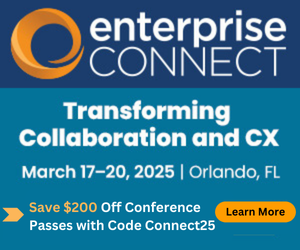Hybrid Work: IT, HR, Facilities Come Together Like Never BeforeHybrid Work: IT, HR, Facilities Come Together Like Never Before
As many workplaces embrace hybrid work, cross-departmental collaboration between IT, HR, and facility departments will be crucial to pulling it all off, according to one Cisco exec.
October 12, 2021

With 2022 looking like a better year for in-office working, many workplace leaders are rolling up their sleeves and getting serious about what the future of work will look like for their organizations. One word keeps popping up in the discussions: hybrid.
The future of hybrid work, i.e., when employees move between on-premises and remote work environments, was a major theme coming out of the September 2021 Enterprise Connect event, which featured sessions and panel discussions on how technology could enable hybrid work. But while the majority of hybrid-work sessions leaned heavily on the IT side of things, the keynote from Jeetu Patel, EVP & GM of security and collaboration business units for Cisco, shared how IT, HR, and facility professionals are collaborating to make the future of work a reality.
"We believe the future of work is going to be definitely hybrid," Patel said. "The interesting thing about hybrid work is that in many more ways it's more complex than when everyone worked in the office or when everyone ... started working at home." To back up his claim, Patel cited research from staffing firm Adecco Group, which reported that 77% of employees will embrace a flexible working style in the future.
Part of that complexity will come in enabling video collaboration in more spaces. Cisco's Webex, Zoom, Microsoft Teams, and other cloud-based meeting services became the lifeblood of many workplaces, but as employees head back into the office, they're looking for that same videoconferencing ability or better in office meeting rooms and collaborative spaces. "While there are 110 million meeting rooms and classrooms around the world, only 6.4% of them are video enabled," Patel said, citing Frost & Sullivan's research on video conferencing devices.
However, tech decisions and enabling wide-spread video collaboration isn't the only complexity; that's where HR and facilities come in. "HR and people teams are going to be thinking about the impact of hybrid work on culture and employee well-being and recruiting and retention and team dynamics and so much more, and facilities [teams] are completely reimagining the physical workspace itself," Patel stated. Not only will facility professionals have to configure spaces for the people who are working in the office, but they'll have to ensure remote participants have a great experience as well. No longer is it acceptable for remote workers to have a second-class experience.
The concept of IT, HR, and facility professionals coming together to address workplace challenges isn't new — it's the foundation of WorkSpace Connect. But what's different today is how closely these departments will work together and how much they'll need to each lean on the other for complementary expertise.
Workplaces that are returning to the office or shifting to a hybrid work model will need this cross-departmental collaboration to ensure a smooth transition to a post-pandemic workplace model. This partnership will also allow workplaces to incorporate the lessons that they learned through the pandemic into an ever-evolving workplace strategy in 2022 and beyond.





